=================================================================
To subscribe, unsubscribe or change your email address, visit:
http://www.imaging-resource.com/IRNEWS/index-subs.html
Support the Newsletter!
- Find the best price for anything at http://ir.pricegrabber.com
- Shop Amazon, Adorama at http://www.imaging-resource.com/buynow.htm
========================================================
THE IMAGING RESOURCE DIGITAL PHOTOGRAPHY NEWSLETTER
========================================================
Volume 16, Number 10 - 16 May 2014
----------------------------------------------------------------------------
Copyright 2014, The Imaging Resource. All rights reserved.
----------------------------------------------------------------------------
Welcome to the 387th edition of The Imaging Resource Newsletter!
Welcome to your regularly scheduled Imaging Resource Newsletter for May 16th! It's been another busy week, and yours truly (Dave Etchells) is home alone today, with Associate Editor William Brawley cavorting in New Orleans, putting Olympus' new TG-3 Tough camera through its paces, and Operations Manager Dave Pardue taking a well-deserved and looong-overdue 4-day weekend off in the mountains with his family.
In the reviews department, we lead off with an excerpt from Mike Tomkin's latest Shooters Report installment for the amazing Fuji X-T1; too long to include all of it in an already overflowing newsletter issue, but well worth clicking over to the site for the full story - this is one nifty little travel companion! Following that is our latest lens test, of the Pentax 20-40mm f/2.8 Limited HD lens. You'll also find Dave Pardue's review of the (exceptional) TCON-17 teleconverter for the Olympus Stylus 1; together, an incredible combination for far-reaching telephoto photography, with amazing image quality for such a compact, affordable kit.
On the feature side, you'll find a brief article by Steve Meltzer on the earliest-born person ever to be photographed, and a look at our April Photo of the Month winners. (Have you considered entering our Photo of the Day contest? It's tough competition, but you could win up to a $300 gift certificate from Adorama Camera, to help support your photo habit!)
Finally, you'll find a whole 'passel ('passel means "a whole lot of", here in the southeastern US) of new product announcements. Samsung's out with their latest mirrorless offering, the bargain-priced NX3000, Nikon's announced that the J4 is coming to the US market, as well as a new super-fast S2 model, both in their 1-series line. Nikon also has a new 400mm f/2.8 supertele, and a 1.4x teleconverter to go along with it. Sony continues their mega-popular RX-100 series with the RX-100 III, sporting a pop-up viewfinder(!), brighter zoom lens and whole host of other enhancements.
As always, we wrap up with a list of some of the most interesting items from the IR news page over the last 2 weeks.
Happy reading!
---
EDITOR'S NOTE: New newsletter email address - nleditor@imaging-resource.com
We apologize to all of our reader's who've emailed us for our long-running reader emails and questions section of the newsletter and never received a response. Our old newsletter editor email address got completely overwhelmed with irrelevant PR emails and spam, to the point that it just wasn't workable to sort through the hundreds and hundreds of messages to find the reader queries. The new address -- nleditor@imaging-resource.com -- is pristine, though, so we'll be able to easily see and respond to all of you, just like old times. Have a question or comment? Just ask!
---
TOPICS
------------
- Get Social with IR
- Sponsors
- Reviews:
- Fujifilm X-T1 Shooter's Report II
- Pentax 20-40mm Limited HD Lens Review
- Feature:
- "Remarkable photo of earliest-born person ever to be photographed"
- by Steve Meltzer
- Quick Hits:
- Olympus TCON-17 teleconverter review, excerpt
- Fujifilm X-T1 Image Quality Comparison
- New Camera/Lens Announcements
- Samsung NX3000
- Nikon J4 coming to the US
- Nikon S2
- Sony RX100 III
- Nikon 400mm f/2.8 and 1.4x teleconverter
- Popular News
- Next Issue
- Signoff
GET SOCIAL WITH IR
----------------------------------
If you want to stay up-to-date with the latest camera and photography news, get notified when IR posts its latest camera or lens review, and much more, get social with us on your favorite networking sites by:
By doing so, you'll also be supporting our efforts to deliver the best camera and photography content on the planet. (Google in particular appears to pay lots of attention to Google+ in deciding site/page relevance for its search results, so "circling" us there and +1-ing our site and pages would be an especially big help.) Thanks! We appreciate it!
SPONSORS
-----------------
This issue is sponsored in part by the following companies. Please show your appreciation by visiting the links below. (Visiting our sponsor's links really helps support this newsletter, thank you for your attention!) And now a word from our sponsors:
* Sigma *
---------
Sigma's approach to photographic equipment is based on quality, craftsmanship, value, customization and
responsibility to photographers and the environment. All encompassed in our breakthrough, award winning
Global Vision lenses:
18-35mm F1.8 DC HSM
35mm F1.4 DG HSM
17-70mm F2.8-4 DC Macro OS HSM
120-300mm F2.8 DG OS HSM
USB Dock
All designed to deliver the highest optical quality and performance.
* Imaging Resource*
------------------------
Did you know that anything you buy from Amazon can support IR, if you just use one of our
links to access the site? Here's a link with our affiliate code in it; click on it, and we'll get a credit
for anything you purchase in the next 24 hours!
http://www.amazon.com/?tag=theimagingres-20
No added cost to you, but a nice boost for us, to help us keep producing this content!
Thanks!
-----------------------------------------------------------------------------------------------------
Are you in the digital photo business? This newsletter is read by more than 47,000 direct subscribers (plus additional pass-along readers), all with a passion for digital photography. For information on how you can reach them, contact us at nleditor@imaging-resource.com
-----------------------------------------------------------------------------------------------------
Camera Review: Fujifilm X-T1 Shooter's Report II
by Mike Tomkins
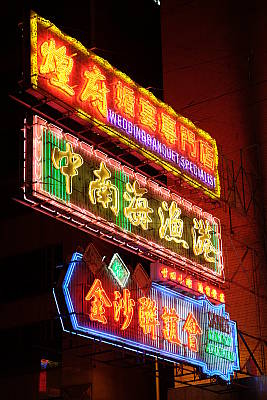
Neon signs like these, a fast-disappearing part of Hong Kong's heritage, are hard to capture in a photo. They're extremely vivid, and clip very easily.
As you'll have seen in the first part of my Shooter's Report, I was having plenty of fun shooting with the Fuji X-T1 in the daytime. (Missed it? Catch up here.) But how would this deliciously retro body handle itself in more difficult conditions? I wanted to get a feel for it both in lower light, and with Hong Kong's famous city lights.
My first introduction to low-light shooting with the X-T1, though, was something of an accident. Shortly before my trip, a sizable Vietnamese cargo ship called the Sunrise Orient was wrecked on the island of Cheung Chau after its crew, fearing an imminent capsizing, abandoned ship with the engines still running. It struck me as a pretty unusual photo opportunity, and I set off in search of the wreck with an idea of what I wanted to shoot, but with no knowledge of precisely where the unmanned ship had eventually beached itself.
My intention was to get close to its bow, and shoot a bunch of low-to-the-ground, wide-angle exposures to emphasize the ship's size. Each would be tripod-mounted, shot at low sensitivity and with a narrow aperture to get a longer exposure time, and then I'd stack them to blur out the waves even more. (I didn't see it until after my return from Hong Kong, but this awesome shot by local photographer Joe Chen is very close to what I'd been planning.)
I knew the Sunrise Orient was stranded somewhere on the eastern coast of Cheung Chau, and at three in the afternoon, chose to start my search from what seemed a promising location on the southeast corner of the island that seemed (from a look at Google Earth) to match the shape of the bay as I'd seen it in others' photos of the wreck. As it turned out, I'd chosen the wrong end of the island though, and by the time I first spotted the wreck three hours later -- with the help of a friendly local photographer who guessed what I was searching for and set me on my way -- I was already down to the dying minutes of the day.
Worse still, I had only my partially-charged cellphone's LED flashlight to guide me home on an unlit, rough and unfamiliar trail, having not been expecting to be out til sunset, let alone after it. After twenty minutes more walking, I realized that there was no chance of my even arriving at the wreck before dark, and diverted to a different path that would at least get me within a quarter mile. And finally, 15 minutes after sunset, I set up my tripod at a small pagoda near Coral Beach (Tung Wan Tsai), with darkness quickly falling. I had time for just two attempts at the long exposure shot I was hoping for, and from a lot farther away than I'd intended, as well. (Thankfully, I had Fuji's 55-200mm zoom with me, or it'd have been an entirely lost cause.)
|
Initially, I'd planned to shoot the Sunrise Orient shipwreck toward the bow at wide angle, and low to the ground. Sadly, I didn't find it in time to get there before dark, and had to settle for a telephoto shot from the rear. The long exposure that blurs out the waves isn't so noticeable or dramatic from this angle. I've corrected the brightness post-capture; the original shot is in the gallery. |
Eyeballing the exposure at around 30 seconds and f/22, I was at least in the ballpark, but had failed to account for how quickly the light was disappearing. Before correction, the shot appears rather underexposed. My second attempt was a 45-second exposure at the same aperture, but within the space of just one minute, the light had dimmed enough that it was even darker despite the much longer exposure. And that was it -- my time was up, and if I didn't leave immediately I wasn't going to be able to find my way safely back to civilization.
The original shot is in the gallery, and above is one corrected simply with a click of the Auto Contrast control in Photoshop, bringing it back to the look of daytime. Even if it's not remotely what I was going for -- the blurred sea doesn't really work from this angle, and the ship's framing isn't very dramatic -- I think it's still a neat shot. But oh, what could have been, had I gotten there earlier or brought a flashlight -- as did one of the photographers who didn't get lost, visible in the background of my shot near the wreck.
By the time I got back to the ferry pier, it was completely dark. I rather liked the juxtaposition of a huge, gas-guzzling ferry against Cheung Chau's many eco-friendly bicycles in the foreground, and grabbed another shot. It was taken in very difficult lighting, though -- a predominantly white ship, and lots of white / silver on the bicycles in the foreground too, but with each under totally different light sources. Ricoh's Multi-Pattern Auto White Balance would probably have come in handy here, as Fuji's auto white balance left the bikes extremely warm. (Although saying that, I actually fiddled with the original raw file in Lightroom to improve the white balance on the bikes without changing that of the ship, and found myself preferring the original shot anyway, so perhaps the camera's choice was for the best.)
|
Difficult lighting, but I think the X-T1, with its 18-55mm f/2.8-4 lens mounted, handled it pretty well. |
Eager to rest my legs after what had proven to be a rather difficult and strenuous day, I headed for supper and my hotel. I grabbed one last shot that I rather liked on the way, again in very difficult conditions. Love it or hate it, the rather divisive 1881 Heritage mall in Tsim Sha Tsui -- which couples a restored, historic Marine Police headquarters with a faux-historic shopping mall -- is undeniably photogenic. It's also permanently packed with photographers and a mass of tourists grabbing photo opportunities in the courtyard. As I walked past, a display with gigantic, fake flowers as its centerpiece was attracting quite some attention. Despite all sorts of light sources, many of them glaring right at the lens, the X-T1 did a pretty good job braced against a handy pillar, and set to ISO 1250.
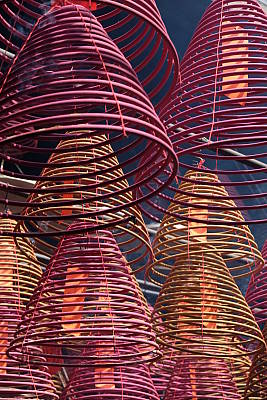
In real life, the colors of these incense coils in Yau Ma Tei's Tin Hau Temple are quite a bit more vivid. A quick tweak in Photoshop brings them right back to life, though.
The following day, I visited the Tin Hau Temple in Yau Ma Tei, which is devoted to the goddess Ma Zou, protector of fisherman. Although doing my best to remain quiet and respectful, I took quite a few pictures there. I particularly loved this shot of incense coils burning in the ceiling, even if they're much more vivid in real life than the shot makes them seem. A bump of vibrance and saturation restores their color. The lighting isn't actually as low as it seems -- quite a bit of sunlight filters into the temple, so the camera needed only a 1/160 second exposure at f/5.6 and ISO 200.
It wasn't until a couple of nights later that I got back to some real night shooting, this time at the harbor front before the nightly Symphony of Lights laser show. I wanted to get a nice panorama of the harbor, and so I spent a while playing with the Fuji T1's built-in pano function.
As you'll see below, I managed to get a panorama I'm pretty happy with, although I prefer it after tweaking to combat the haze a bit. (Of course, the haze isn't the camera's fault; you'll see the untouched original in the gallery.)
It did take quite a bit of work to get this result, though, for two reasons. Firstly, since the panorama length is predetermined -- you can opt for a shorter or longer panorama, but can't simply sweep and then let go of the shutter button at your chosen length -- it's hard to tell where to start off, to end the panorama right where you want. Secondly, the X-T1 struggles badly with motion or change in exposure during a panorama. The signs blinking on and off on the opposite side of the harbor caused sudden changes in brightness between frames, and the boats passing in the foreground turned into a mess of jumbled slices.
After a bunch of attempts, though, I managed the panorama shown below:
|
I still cut off the building at right, but I'm otherwise very happy with this panorama. This shot has been tweaked to reduce the haze in the sky; see the original in the gallery. |
I also got what's probably my favorite single shot of the whole trip, a tighter-framed shot of Central district from the Bank of China to The Center. I actually shot this scene as a set of three fairly closely-bracketed exposures, but later decided to merge them into a single shot using Unified Color's HDR Expose 3. I fiddled with the controls for a little while to get a bold, contrasty look which brought down the haze a bit, while leaving a trace of the ridge line behind the skyscrapers.
|
This shot -- actually a stack of three separate frames, all of which are in the gallery -- will be going up on my wall. The vibrance of downtown Central is captured very nicely by the Fuji X-T1. |
As an added bonus, it also salvaged the lights which extended only part-way up the Bank of China building -- "the zig-zag skyscraper", as my five year old son calls it -- as it had been only partially-illuminated in the best-exposed single frame of the trio. I think I'll print this shot out and hang it over my desk as a reminder of home.
I rounded out my night's shooting with a couple of the fast-vanishing neon signs with which Hong Kong was once so very closely associated. (Sadly, they're becoming something of a rarity these days.) These are so vivid and strongly-saturated that they can present quite a challenge to photograph. They're just plain fun to shoot, though -- I was like a kid, playing with exposure and fiddling with zoom during exposures as I wandered around snapping photos. I was very pleased with the results I achieved with the X-T1 -- enough so that I've proudly added a couple of my shots to M+ Museum's online compendium of Hong Kong neon signs.
[Hop on over to the site, for the rest of Mike Tomkin's latest shooter's report on the Fuji X-T1 - there's loads more to see and read, including a nifty shot of some neon, an example of a night-time in-camera panorama, and an amazing (even if braced against a railing) hand-held 2.4 second time exposure. Mike was pretty jazzed with the X-T1 as a traveling companion, read more about why!]
---
Lens Review: Pentax 20-40mm Limited HD
Limited Series first zoom is sharp, well-built but pricey
by William Brawley
Over at SLRgear, we've just published our�review�of Pentax's newest edition to their HD Limited series of lenses: the�Pentax 20-40mm f/2.8-4 ED Limited DC WR HD DA. The first zoom lens of the Limited series get the same "HD" coating treatment as the recently reviewed�Pentax 35mm f/2.8 Macro Limited HD DA�and�Pentax 70mm f/2.4 Limited DA HD. Pentax's new High Definition co
ating allows a higher light transmittance and more clarity, for improved contrast and better flare reduction.�
Despite the relatively retro-esque, all-metal exterior design, there are a few more modern touches to this lens than with the other Limited series glass. The Pentax 20-40mm is weather resistant with seals throughout the barrel (7 total) and a gasket on the mount. It also has a much quieter DC autofocusing motor, and while the aperture is variable throughout the zoom, it's fairly bright at f/2.8-4 rather than the more typical f/3.5-5.6 variety.�The optical layout is comprised of 9 elements in 8 groups, including 1 Extra-low Dispersion and 1 Super Low Dispersion element, and a 9-bladed rounded aperture for nice, out-of-focus backgrounds.
In terms of test results, the new Pentax 20-40mm f/2.8-4 ED Limited DC WR HD DA lens displays excellent sharpness, especially in the center of the frame or, better yet, when you stop down a bit. Chromatic aberration, distortion and vignetting are all present to varying degrees depending on focal length and aperture, but it's all very minor and something your average photo editing software should be able to clear up.
Jump on over to SLRgear to read our full�Pentax 20-40mm f/2.8-4 ED Limited DC WR HD DA lens review�to see our test results and read our current verdict, which are based on RAW file output.
Like other HD Limited lenses, the Pentax 20-40mm f/2.8-4 ED Limited DC WR HD DA is available in either black or silver. The lens ships with a push-on metal lens hood and front and rear caps for around $996.95:�Adorama:�Black,�Silver�|�Amazon:�Black,�Silver�|�B&H:�Black,Silver. By purchasing this lens, or any other product, by clicking on one of our trusted affiliates, you help keep these reviews coming!
In the meantime, check out some sample photos shot by our senior lens technician Rob Murray. You can view more sample photos, plus download the full-resolution files, over at�our Flickr page.
|
Pentax K-5: 20mm, f/8, 1/640s, ISO 100
|
|
Pentax K-5: 29mm, f/8, 1/250s, ISO 100
|
|
Pentax K-5: 20mm, f/5.6, 1/160s, ISO 100
|
-----------------------------------------------------------------------------------------------------
FEATURE: Remarkable photo of earliest-born person ever to be photographed
by Steve Meltzer
Born in 1749, New Englander Conrad Heyer was a veteran of the American Revolution. He was there in Trenton during the terrible winter of 1776 and crossed the Delaware River with General George Washington and his rag-tag Continental Army. In fact, the Maine Historical Society believes him to be the earliest born human ever photographed.
This photograph of Heyer is thought to have been taken in 1852. As such, it’s hardly the first American portrait photograph, but given the date of his birth he could well be the oldest human photographed. He is also the only photographed Revolutionary War veteran who served with Washington.
The photograph was taken using the daguerreotype technique, which first debuted in 1839. Within a few years portrait studios employing the technique had proliferated all over the young American landscape. The few remaining photos we have from the first half of the 19th century provide a window into a world otherwise accessible only through the written word.
And this is a magnificent portrait, both in its content and its composition. Heyer's body faces to the left while the light coming from behind his right shoulder adds drama. His head, turned towards the camera, adds a sense of confrontation. And take a close look at that face. At 103, Heyer looks into the camera, steady, stern and still defiant.
http://www.mainememory.net/artifact/13423
http://www.newmarketpressvt.com/news/2013/jul/25/new-england-man-had-oldest-birth-date-ever-be-phot/
http://www.findagrave.com/cgi-bin/fg.cgi?page=gr&GRid=37178469
---
Black & White photos steal the show: We vote in our April Photo of the Month winners
by Dave Pardue
We tend to be happier when there's good variety in our Photo of the Day monthly winners. A portrait here, a landscape there and perhaps a new take on an animal photo or even something extreme. But it's also interesting to note when there's a commonality to the winners of any given month, and this month we noticed one big obvious: all three prize winning photographs are�black and whites.
Also of special interest to point out is that, for the first time in the history of our contest, we have the same first and second place winner as the previous month, Sean Rooney and Melissa Anderson. Congratulations to these two wonderful photographers, whose names you may already know from all of their terrific previous daily winners. We're grateful for the quality you bring to our contest.
Thanks to everyone who entered this month. The top three winners all receive gift certificates from�Adorama�of $300, $200 and $100, respectively. Congratulations to these winners and to the worthy runners-up.
Please keep the terrific submissions�coming our way!
|
First Place � Black & White by Sean Rooney � Nikon D4
|
| Wow! I seem to use that word a lot with our POTD winners, and for good reason. This is an absolutely stunning image, with a number of elements contributing to its appeal. At a very broad level, the contrast of the jagged mountain crags and contrasty foreground elements with the soft layer of mist and the clouds above provide a great deal of visual interest. One thing that immediately struck me is the way the contrast and mass of the driftwood and reflections in the foreground balance the mass of the mountain above, "reflecting" each other across the dividing line created by the mist. Without the mist above the water, the image would be much less interesting. It's a superb composition. The other thing that I noticed was the excellent tonality. Sean created a very high-contrast image here, but one that uses the available dynamic range of our 8-bit displays perfectly: There are only a very few areas of the image that go all the way to 0-black or 255-white; th
ere's detail even in the bright highlights and deep shadows. If this were a film image enlarged and developed into a print, I'd say it was a perfect example of Ansel Adam's "Zone System" put into practice. (Actually, the principles of the Zone System apply equally to digital photography, but a lot of it had to do with how the film and paper were exposed and developed, to fit the tonal range of the subject into that achievable in a photo print.) An absolutely fantastic image, with brilliant composition and incredible tonality. Congrats, Sean! |
|
Second Place � Fire And Ice by Melissa Anderson � Canon 50D
|
| This must be "Tonality Month" for the IR POTD contest - Just as Sean's did above, Melissa's lovely image here uses every bit of the monitor's tonal scale; only a few bits of the image go either totally black or totally white, and the scale in between is used to wonderful effect. There's an awful lot to like here; it's hard to decide what to talk about first. I guess first is the wonderful sense of depth, created by the fog and the way the trees fade gently into the background. We're accustomed to seeing fog or haze like this in daily life, so our eyes and brain immediately translate this effect into an indication of depth or distance. Here, the starkness of the black trunks in the foreground heightens that sensation. Then there's the obvious contrast between the stark, vertical trunks and the soft blanket of snow on the forest floor. There's an added detail, though, that really makes the picture for me, and that's the snow clinging to the bottoms of the tr
unks. It's almost as if the blanket of snow was reaching up to cover the trees as well. Beyond any fantasized emotional contribution, the show on the trunks provides an excellent and needed transition from the soft mounds of snow to the stark trunks. If the snow on the trunks was removed but everything else held constant, It would still be an interesting picture, but I don't think it'd be the great one that Melissa captured. Big congrats to Melissa, not only for her photo skills, but the perseverance to apply them - my feet feel cold and wet from tramping through the snow just looking at this! |
|
Third Place � Horseboy by Goran � Konica Minolta 5D |
Landscapes and still lifes have to stand solely on composition, tonality, and/or color, but portraits are all about emotion and revealed character. This shot does a great job in that regard, while (once again) making good, intelligent use of tonality. It does lose detail in the deepest shadows, but I don't see it as a major issue, and the blown-out sky is important in isolating the subject(s). Compositionally, it could be an illustration for the rule of thirds, with both subjects well-positioned, roughly at the two top corners of the central area. Stepping back from the image a little, I'm struck by how effectively the composition draws attention to the young man's face. Some of it simply that his face anchors a large and generally triangular-shaped area of white at the top of the picture, but it perhaps goes even a bit deeper than that. Our eyes always want to "connect the dots," to understand the structure of our surroundings, and I think there's a littl
e of that going on here. Notice the angle of the roof in the background, between the horse and the boy, and note how that angle connects with background elements in the far upper left-hand corner of the frame. The line thus formed points directly at the main subject's face, and I think plays a big role in giving the picture the impact it has. Having started by saying that portraits are all about emotion and revealed character, I've now droned on at length about composition, but my first, visceral reaction to this image is all about the young man's expression. It's always risky, trying to be too specific about reading others' emotions from pictures, but I get a strong sense of the boy's amused affection towards the horse. It's enormously engaging; I find it impossible to look at without smiling myself. All in all, a beautiful portrait, beautifully composed.
Congrats, Goran! |
|
First runner-up � Winter Portrait by Steve Webb � Nikon D7100 |
| This is just a great little nature shot, but one that probably took a lot of patience, time, and care to pull off. Not only is the focus perfectly placed, but the slight 3/4 (7/8?) angle of the bird's body and its slightly cocked head make for a pretty much perfect portrait shot of the little guy. Great work, Steve! |
|
Second runner-up � Sundown by Scott Vomvolakis � Nikon D40 |
Some shots just tug at our heart strings (a lot of us at IR are dog-lovers), and this photo combines the memes of a faithful dog and the relaxation and peace of a beautiful sunset. It has something else going for it as well, though, namely the highlighted fur on the dog's legs. That provides great separation from the background, helping us see the dog as more of a complete subject, and lending great depth to the shot that otherwise would be missing.
Really nice work, Scott! |
[Commentary and analysis compliments of our publisher, Dave Etchells]
For anyone wanting to know more about our competition please visit�this news story�which describes our contest and also offers some useful tips to help you succeed. To see camera and exposure information on this month's winners or to visit previous months please visit our�POTD winner's gallery.
[Ready to submit a photo of your own? Just�click here!]
-----------------------------------------------------------------------------------------------------
QUICK HITS
---
Lens Review: What happens when the Olympus Stylus 1 meets the TCON-17? We review the 510mm f/2.8 transformation
by Dave Pardue
The TCON-17 1.7x teleconverter is designed to extend the 35mm equivalent focal length range of the Olympus�Stylus 1 from 300mm to 510mm, quite a sizable jump indeed, all while still maintaining the bright f/2.8 constant aperture. This is currently unrivaled by any camera in the price range of this combination, other than the Panasonic FZ200, which extends to 600mm eq. f/2.8 but has a smaller 1/2.3" sensor, which is somewhat limited in comparison for both low light performance and image quality.
To attach the TCON-17 to the Stylus 1 you first unscrew the lens cap, then screw on the conversion lens adapter [CLA-13 - available for around US $40] and then screw the TCON-17 onto the adapter. The result is quite an impressive looking rig indeed.
|
Olympus Stylus 1 ($649) + CLA-13 ($40) + TCON-17 ($199) = 510mm f/2.8 for ~ $888
|
My first impression of the TCON-17 was how solid it felt when I first pulled it out of the box, and that huge piece of glass sitting out front is very impressive, too. The unit screws on with a reassuring metal-on-metal precision, and the look of the whole rig is quite unique. The best part is the way it rests in your left hand, with a wide rubber grip that's just right for your thumb and forefinger. I've read that some shooters felt the teleconverter was too large for the smaller bodies of the Olympus XZ-1 and XZ-2, but I felt that it balanced rather nicely on the Stylus 1, both in terms of the weight, and also for the visual appearance. (Perhaps as a qualification, though, it feels just fine to me on my little XZ-1 as well, because in both cases I'm primarily holding the lens.)
Switching the camera on for the first time with the conversion lens, you'll see an odd vignetted image with dark corners on the LCD or EVF before the lens has been zoomed out, but once you zoom far enough (past about 7.1x), this goes away. It's important to note here that the camera menu (under menu #2) contains an icon of this unit with a setting for TCON-17. By switching this on, the lens will automatically extend to the full telephoto position when the camera powers on, saving you the trouble of having to zoom out. We'll discuss that setting more in just a bit.
|
Special menu setting for the TCON-17 |
Performance. Conventional rear-element conversion lenses have traditionally suffered from typical drawbacks inherent in their design, such as being less sharp, deceasing the effective aperture and thus affecting exposure values, as well as introducing other issues such as chromatic aberration and distortion. We'll take a look now at how the TCON-17 grapples with these common setbacks, and then move onto real world images.
The first thing to mention is that there is no noticeable decline in autofocus speed or performance when the TCON-17 is attached. AF operates smoothly and efficiently, similarly to the Stylus 1 with only its built-in lens, the only minor difference being that it takes a few milliseconds longer on average to go from close focus to infinity. The difference is almost imperceptible, though, and is a natural by-product of the longer effective focal range. And while we're discussing focus, it bears noting that you aren't able to achieve good macro performance with the teleconverter attached. As seen from the examples below, the effective close range is less than that of the fixed lens at 300mm, and far less than the lens at wide angle with "super macro" enabled.
|
Olympus Stylus 1 ($649) + CLA-13 ($40) + TCON-17 ($199) = 510mm f/2.8 for ~ $888
|
|
510mm eq. (TCON-17) � |
closest effective focus � � |
300mm eq. (fixed lens) |
|
510mm eq. (TCON-17) � |
closest effective focus � � |
300mm eq. (fixed lens) |
[note: super macro mode can't be enabled with the teleconverter attached] |
This isn't a complaint, because as mentioned in our�Stylus 1 review, the super macro mode allows the camera to get incredibly close on its own - just a mention for anyone expecting to be able to use the longer zoom range to macro advantage. The TCON-17's power is in bringing distant objects a whole lot closer, and indeed it does.�
Sharpness. I enlisted our senior lab technician Luke Smith to shoot our VFA test target in order to compare sharpness from the TCON-17 against that of the Stylus 1's fixed lens on its own, and the results are shown below. The first is a crop at full resolution from the center of the target, and the second a crop from the top left corner of the target to demonstrate any potential issues with corner sharpness or aberration.
|
510mm eq. (TCON-17) � |
100% |
300mm eq. (fixed lens) |
[testing center sharpness] |
|
510mm eq. (TCON-17) � |
100% |
300mm eq. (fixed lens) |
[testing corner sharpness] |
The center is not quite as sharp as we see with the Stylus 1's fixed lens by itself. The decline is not severe though, and this is seen at 1:1 resolution, so is a pretty magnified view. The results in the corners are a bit worse though, as there is certainly less sharpness and also some obvious chromatic aberration occurring. This is not unusual for a teleconverter, and we've seen much worse examples than this. Still, anyone needing critical sharpness in the corners should take note here, as well as anyone concerned with the slight chromatic aberration as you get further from center.
Exposure. One other common complaint often heard regarding typical teleconverters is the loss of light caused by the spreading of the light coming from the attached lens, forcing longer shutter speeds to effect the same exposure. I checked for this with the TCON-17 in a variety of shooting conditions, and saw virtually no difference in exposure values when switching back and forth. You won't need to worry about exposure performance when attaching the teleconverter to the Stylus 1.

As mentioned earlier, there is a menu setting called TCON-17 (in camera menu #2 with a teleconverter icon) that zooms the camera to the full tele end during power-up. This is helpful for two reasons. First, if this isn't enabled, the camera powers up to wide angle, which results in darkened corners of the image when the teleconverter is attached. It's nice to start working from the tele end, when that's what you're after in the first place. The second benefit is that the camera will properly record the EXIF data and give accurate focal length settings. These two differences were the only effects that our lab technician or I were able to find. We didn't notice any difference in sharpness, any corrections for CA, etc, so if you forget to turn the setting on, your resulting images will still be the same (assuming you zoom out beyond a 300mm eq. range) and only your EXIF data will be off, which most people won't care about anyway. [Thanks to a helpful comment from our reader
DavidG we were able to determine that enabling the TCON-17 setting also causes the image stabilizer (when engaged) to behave more aggressively in order to compensate for the longer effective zoom range, so an even more compelling reason to make sure it's enabled.]
Check out the selection of real-world images using the TCON-17 as well as the final verdict on this very handy adapter lens over at Imaging Resource! http://www.imaging-resource.com/news/2014/05/10/olympus-stylus-1-meets-tcon-17-transformation
---
Is the Fuji X-T1 the sharpest APS-C camera out there? You be the judge: Image comparison tables posted
by�Dave Pardue
The Fujifilm X-T1 has been far and away one of the most popular cameras on our site this year, and that's without a full review yet posted. With the retro ergonomics, the reported super-fast AF speeds and a supporting cast that includes an excellent lens line and a very useful portrait battery grip, this is no surprise.
But anyone interested in a camera in this price range is going to want image quality first and foremost, and our lab test images and comparison tables are here to help you figure out if this model stands up to the competition across the ISO spectrum for sharpness, detail, color and noise levels.
With that in mind we've just posted our�Image Quality Comparison�section as well as our�Print Quality�Analysis�for the Fujifilm X-T1. Here you can view lab test image crops beside several popular competitors in this price range including the Canon 70D, Fujifilm X-E2, Nikon D7100, Pentax K3 as well as the full frame Sony A7.
To whet your appetite, below is the X-T1 up against the Pentax K3 at ISO 1600.
|
Our Image Quality Comparisons offer side-by-side views with technical analysis |
� [quick links:�Fujifilm X-T1���Image Quality���Print Quality���Gallery]
-----------------------------------------------------------------------------------------------------
NEW CAMERAS AND LENSES ANNOUNCED
------------------------------------------------
Canon expands ultra-wide zoom selection, preps Stormtrooper-friendly Rebel SL1
by Mike Tomkins
Good news, wide-angle fans: Canon just boosted its selection of ultra-wide angle zoom lenses by half, thanks to two brand-new lens models. Neither is a direct replacement for an earlier optic -- instead, they sit alongside the company's four existing EF and EF-S ultra-wide zooms. And alongside the new lenses, the company has also revealed a Stormtrooper-friendly white version of its tiny Rebel SL1 DSLR, arriving soon.
The�Canon EF-S 10-18mm f/4.5-5.6 IS STM�is far and away the company's most affordable wide-angle zoom to date, priced at just US$300. It's also the smallest and lightest by quite some margin, making for a particularly nice pairing with the compact Canon SL1 body. (It will work on any EF-S body, though.) The EF-S 10-18mm costs less than half as much as the existing 10-22mm f/3.5-4.5 USM optic, which was until now also Canon's smallest and lightest ultra-wide zoom. And although it sacrifices a little zoom range and maximum aperture compared to that lens, it adds image stabilization to the mix. That's a pretty impressive feat, given that the new lens weighs a third less, and is 0.6-0.7 inches smaller in both length and diameter.
|
The Canon EF-S 10-18mm f/4.5-5.6 IS STM lens.
|
The other new offering is the�Canon EF 16-35mm f/4L IS USM, and this looks to us to be aimed at video shooters. It's similar in size and weight to the existing EF 16-35mm f/2.8L II USM lens, but with a list price of US$1,200, it'll save you $500 over the brighter optic. And although you give away something in terms of maximum aperture, you're rewarded with image stabilization. That's probably not a big deal for still shooters -- it's a wide-angle optic, after all, and you'd have gotten a faster shutter speed in the first place with the f/2.8 lens -- but the Canon 16-35mm f/4's stabilization will lend itself nicely to shake-free video.
|
The Canon EF 16-35mm f/4L IS USM lens.
|
Both lenses are slated to ship this June, and so is the new color variant of the�Canon Rebel SL1DSLR body. The white EOS Rebel SL1 kit will be priced at US$750, and comes bundled with a white version of the�EF-S 18-55mm f/3.5-5.6 IS STM kit lens. Not included: a matching Stormtrooper costume, but we recommend one to complete the look.
|
The Canon EOS Rebel SL1 kit in white comes complete with a color-matched EF-S 18-55mm f/3.5-5.6 IS STM lens.
|
Find out more about the Canon Rebel SL1 in our�in-depth review, and find out more about the�EF-S 10-18mm f/4.5-5.6 IS STM�and�EF 16-35mm f/4L IS USM�lenses on our sister site, SLRgear.com.
---
Samsung NX3000 mirrorless saves you money by skipping hybrid AF, touch screen
by Mike Tomkins
Good news for the thrifty this morning: The�Samsung NX3000 compact system camera has just debuted, offering a combination of features from the NX300 and NX Mini at a very affordable pricetag.
The NX3000 takes over from last year's NX2000, and aims to pair the affordability of the NX Mini with the much larger sensor size of an NX-mount camera. So long as compact size and performance aren't your primary concerns, it offers you a chance to save some hard-earned cash.
The 20.3-megapixel Samsung NX3000 is just a little smaller and a fair bit lighter than the NX300, yet boasts the same sensor size, resolution, and sensitivity range as that camera. It does, however, forgo the NX300's hybrid autofocus, and trails it somewhat in terms of burst performance. There are cost-savings in other areas, too: The NX3000 shares the same cellphone-like MicroSD storage slot and slimline battery pack as the NX Mini, and also has a similar three-inch, tilting LCD monitor. And saving even more, it forgoes the touch-sensitive overlay offered by both siblings.�
However, it still gives you the company's NX lens mount and a roomy APS-C imager, not to mention a newer version of Adobe Photoshop Lightroom than that provided with the NX300, which still ships with last year's release. And it will be the first NX-mount model to ship with the company's 16-50mm f/3.5-5.6 OIS power zoom lens as a kit optic (at least, in one of the bundles as mentioned below), good news for video shooters!
The Samsung NX3000 will be available in the same three body color choices as the NX300: black, brown, or white. There will be two kits offered, the first has the NX3000 bundled with the 16-50mm OIS Power Zoom + the SEF-8 Flash for US$529, and the second has the NX3000 bundled with the 20-50mm lens + the SEF-8 Flash for US$479, with availability sometime this June.
For more information visit our�Samsung NX3000 preview.
Place your pre-order with a trusted Imaging Resource affiliate now:
---
Nikon J4 coming to the US after all
by Mike Tomkins
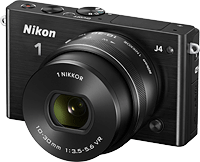
Early last month, Nikon announced its newest mid-range 1-series compact system camera, the Nikon J4 -- but there was a bit of a surprise. Although the camera launched in Europe and Asia, the company's US branch remained silent, implying the camera might not make it stateside. (It wouldn't be the first time we've seen a product simply passed over in one particular market, nor will it likely be the last.)
Today, though, we can confirm that the Nikon J4 will indeed be arriving in the US market. Nikon USA has now officially launched the model, which makes quite a few changes when compared to last year's J3. Most importantly, the J4 adopts a new body style, and swaps in a new image sensor and processor combination that promise the trifecta of greater resolution, performance, and low-light shooting.
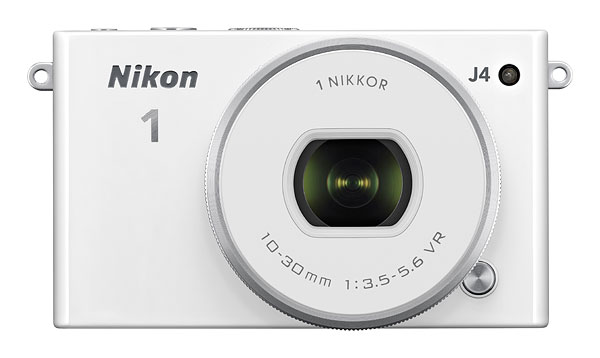
There's also a more sophisticated hybrid autofocus system, a higher-resolution monitor with touch-screen capability, support for image sharing direct from the camera, and more. All that, and yet the Nikon J4 is just a little smaller and lighter than its predecessor.
The Nikon J4 is available in four colors -- silver, white, black or orange. It ships either with the new 10-30mm f/3.5-5.6 PD-ZOOM power zoom lens for US$650, or with the existing 10-100mm f/4.0-5.6 VR lens for US$1,050. A two-lens kit bundles both the 10-30mm f/3.5-5.6 PD-Zoom and 30-110mm f/3.8-5.6 VR lenses, and lists for US$850. The Nikon 1 J4 went on sale from April 24th in the Japanese market, and followed in the US market from May 2014.
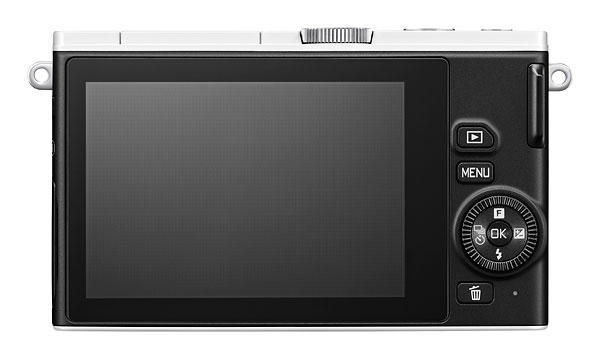
If you want the full story on the camera the rest of the world already knew about (and admit it, so did you!), be sure to read our updated Nikon J4 preview!
---
Affordable Nikon S2 shoots faster than a D4s
by Mike Tomkins
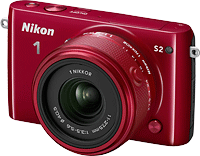
At the start of 2013, Nikon launched its S1 mirrorless camera, setting a new benchmark for 1-series affordability. Almost a year and a half later, the 14-megapixel Nikon S2 follows in that camera's footsteps, and while it can no longer technically be called the most affordable 1-series model, it's certainly far and away the most affordable 1-series camera launched in the year to date.
In terms of styling, the Nikon 1 S2 looks much like its identically-sized predecessor. Softly-rounded corners abound, and it's an altogether cuter, friendlier-looking design than the minimalist, almost industrial look of the pricier Nikon J4.

So what's new? Key among the changes are a higher-resolution image sensor and a faster processor. Together, these allow an increase in both ISO sensitivity and burst-shooting performance. Nikon has also significantly improved battery life since the S1, and the Nikon S2 now uses Micro SD storage and a Type-D Micro HDMI video output.
Other notable differences in the S2 include support for 1080p60 video capture, a new multi-shot ISO Sensitivity Noise Reduction function, and a variety of new creative effects and tools for both stills and video.

Available from June 2014, the Nikon S2 will be available in Black, White, Red or Yellow, with two different kit options. A kit including an 11-27.5mm f/3.5-5.6 lens will be priced at US$450, while a two-lens kit will add a 30-110mm f/3.8-5.6 VR lens to the bundle for $700.
You can find out much more in our just-published Nikon S2 preview!
---
Sony RX100 III boasts brighter zoom, popup viewfinder, and still fits in a pocket!
by Mike Tomkins
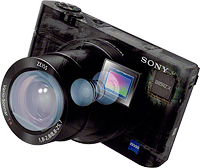
The most exciting series of pocket-friendly cameras on the market just got even more exciting! Sony has taken its past RX100-series models and overhauled them to produce the 20-megapixel Sony RX100 III. And boy, is this ever one cool camera, with major updates throughout.

Changes include a brand-new lens that's bright across the zoom range, plus Sony's latest-generation BIONZ X image processor, improved autofocus, a selfie-friendly 180-degree tilting LCD, and a clever pop-up electronic viewfinder. And the RX100 III makes a much better movie shooter, too, providing better stabilization, full-sensor video capture, zebra striping, and even a clean HDMI output function.
Available from June 2014, the Sony RX100 III is priced at around US$800. Just as with the earlier models, only a black body color will be offered. Find out a whole lot more about the brightest-lensed RX-series pocket zoom to date in our Sony RX100 III preview!
---
Updated Nikon 400mm f/1.8, 1.4x teleconverter lets pros focus on their art, not their aching backs
by Mike Tomkins
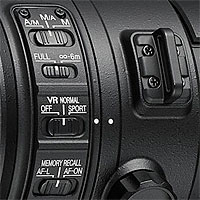
Alongside its brand-new S2 and J4 mirrorless cameras, Nikon also has good news today for enthusiasts and pros who prefer a mirrored camera: updated versions of its 400mm f/2.8 lens and 1.4x teleconverter. Together, they promise to give your aching back muscles a rest, and let you focus on your photography, instead of building upper body strength.
At 8.4 pounds (3.8kg), the Nikon�AF-S Nikkor 400mm f/2.8E FL ED VR lens is still one hefty optic, but it's a lightweight compared to the existing 10.2-pound (4.6kg) AF-S NIKKOR 400mm f/2.8G ED VR. And despite trimming off 1.8 pounds (0.8kg), Nikon says that the new optic will yield better autofocus performance, exposure accuracy, and speed than the existing lens. That's achieved thanks to a new 16-element, 12-group optical formula with two fluorite elements, two ED elements, and Nano Crystal coating, as well as a fluorine-coated front protective element, and an electromagnetic diaphragm.
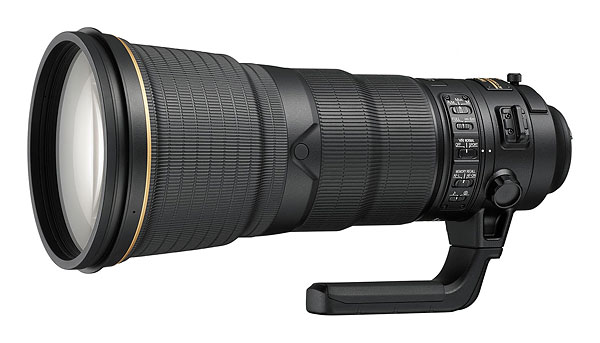
The new optic also has a nine-bladed circular diaphragm for attractive bokeh, and an updated Vibration Reduction mechanism with four-stop correction and VR Sport Mode, which recognizes and accounts for panning motion. Other noteworthy features include a rotating tripod collar and buttons on the lens barrel compatible with the D4S' new AF functionality.
The Nikon�AF-S Teleconverter TC-14E III, meanwhile, follows on from the II version of the same converter. Nikon says that the new variant has improvements both in its optical performance and durability. In place of the earlier five element, five group formula, the new 1.4x teleconverter has seven elements in four groups, with dust and water-resistant fluorine coatings on both front and rear elements. The lens barrel of the new teleconverter also has improved moisture and dust resistance, ensuring you'll feel confident to use your teleconverter in less-than-ideal conditions.
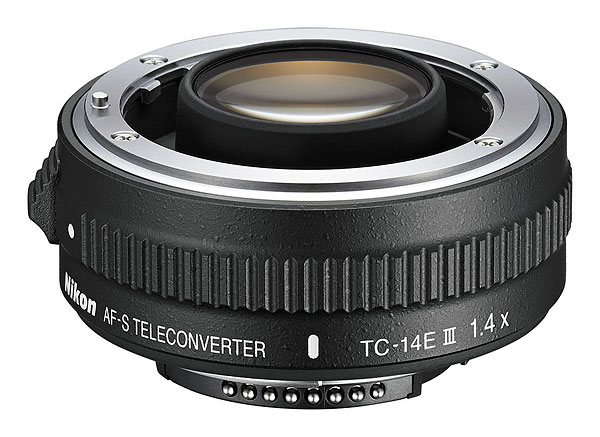
Available from August 2014, the�AF-S Nikkor 400mm f/2.8E FL ED VR lens is priced at around US$12,000, some US$2,500 or so more than the existing 400mm f/2.8 lens. The�AF-S Teleconverter TC-14E III will ship at the same time, priced at US$500.
-----------------------------------------------------------------------------------------------------
POPULAR ON THE SITE
--------------------------------------------
At http://www.imaging-resource.com/news you can keep track of the photo news on our main site. Among the most popular stories over the last couple of weeks:
- A 2.7x crop factor for your FX & DX lenses, but how�s the image quality? We post Nikon V3 First Shots (http://www.imaging-resource.com/news/2014/05/13/a-2.7x-crop-factor-for-your-fx-lenses-we-post-nikon-v3-first-shots)
- Apple awarded iPhone patent on multi-shot �super-resolution� camera system(http://www.imaging-resource.com/news/2014/05/09/apple-awarded-iphone-patent-on-super-resolution-camera-system)
- Parrot drone overhauled with 14-megapixel camera, mile-plus range and first person view support (http://www.imaging-resource.com/news/2014/05/12/parrot-drone-overhauled-14-megapixel-camera-mile-range-first-person-view)
- One time-lapse to rule them all: Stunning video shows you the land of the Lord of the Rings in 4K (http://www.imaging-resource.com/news/2014/05/05/one-time-lapse-to-rule-them-all-stunning-video-shows-you-the-land-of-the-lo)
- A glimpse under a mountain at the world�s largest photo archive (http://www.imaging-resource.com/news/2014/05/02/a-glimpse-under-a-mountain-at-the-worlds-largest-photo-archive)
- Is it a hoax, or is it true? Image sharing service Izitru passes judgment on your photos (http://www.imaging-resource.com/news/2014/05/07/is-it-hoax-or-true-image-sharing-service-izitru-passes-judgement-on-photos)
- Dynamic Perception eyes smartphone timelapse control with new 360-degree motorized head (http://www.imaging-resource.com/news/2014/05/07/is-it-hoax-or-true-image-sharing-service-izitru-passes-judgement-on-photos)
- Geotagging proving fatal for endangered rhinos (http://www.imaging-resource.com/news/2014/05/07/geotagging-proving-fatal-for-endangered-rhinos)
----------------------------------------------------------------------------------------------------
NEXT ISSUE
-------------------
We'll see you next on May 30, with a regularly scheduled edition (and lots more reviews, news and analysis to share)!
SIGNOFF
--------------
That's it for now, but between issues visit our site for the latest news, reviews, or to have your questions answered in our free discussion forum. Here are the links to our most popular pages:
Newsletter Archive: http://www.imaging-resource.com/cgi-bin/dada-nltr/mail.cgi/archive/irnews
Daily News: http://www.imaging-resource.com/news
SLR Gear: http://www.slrgear.com
New on Site: http://www.imaging-resource.com/new-on-ir
Review Index: http://www.imaging-resource.com/camera-reviews
IR Photo Contest: http://www.dailydigitalphoto.com
Google + http://plus.google.com/+imagingresource
Facebook: http://www.facebook.com/imagingresource
Twitter: http://www.twitter.com/IR_Lab
Happy snapping!
Dave Etchells & the IR Editorial Team
nleditor@imaging-resource.com
| 
